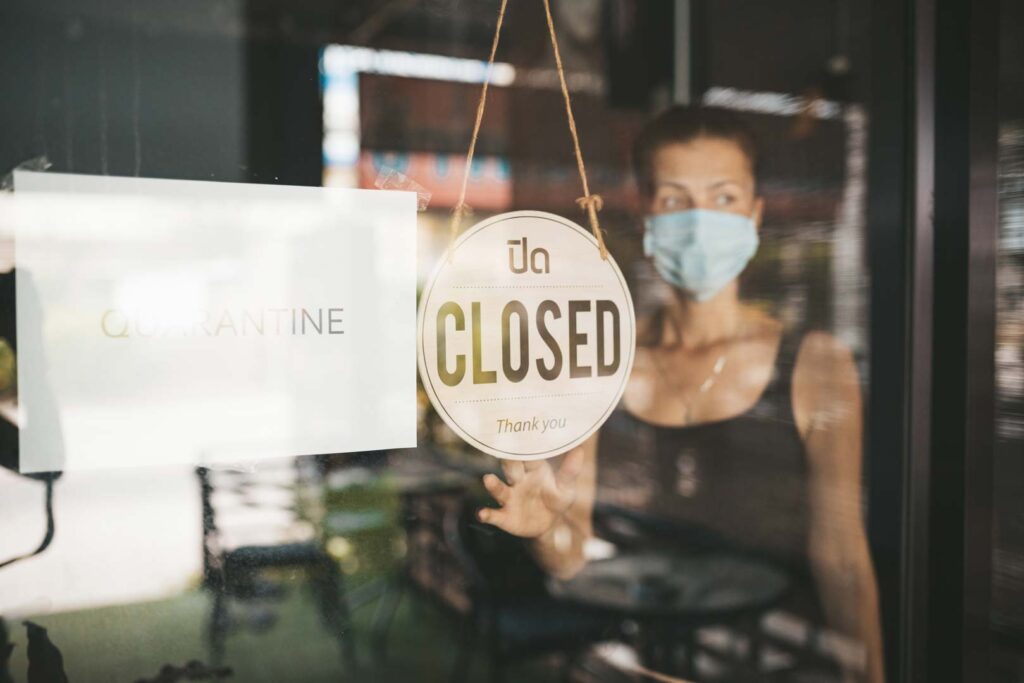By Bryan O. Blevins, Jr.
Equity Partner
The insurance industry responded to the emergency of the COVID-19 pandemic with preemptive press statements that property insurance policies would provide no coverage—even before policyholders submitted any claims. Given this knee-jerk reaction, it is unsurprising that the first claims are being denied quickly, and without so much as a pretense of an investigation.
Physical Loss or Damage
Insurers are taking an “if you can’t see it, then it doesn’t exist” position. But a wide variety of historical Court decisions support the conclusion that actual or threatened coronavirus contamination at or near insured property constitutes physical loss or damage triggering business interruption coverage.
- Commercial property insurance generally covers “physical loss or damage to property” and the resulting business interruption losses.
- Insurance policies use the phrase “physical loss or damage” and similar variations to provide coverage for either “loss” or “damage”. This phrase has been broadly interpreted to mean more than structural damage by including conditions that make the property unusable, such as smoke from a fire elsewhere.
- As such, the “physical loss or damage” that triggers both property and business interruption coverage is not confined to the physical destruction of property. The presence of a contaminant, whether a chemical constituent or a contagion such as COVID-19, may constitute insured physical loss or damage to property, and therefore trigger coverage for resulting economic losses.
- In that vein, a growing body of scientific evidence indicates that COVID-19 can survive for days on surfaces normally considered inhospitable to viruses, such as doorknobs, faucets, and other hard surfaces in buildings.
Insurers are already arguing that insurance policies expressly exclude viruses under “standard form” exclusions.
Courts have widely held that contamination is a form of physical loss or damage if it impairs the use of the insured property. In Port Authority of New York & New Jersey v. Affiliated FM Insurance Co., a federal appeals court held that a building contaminated with asbestos fibers suffered “physical loss or damage” triggering property coverage. The court found that the presence or imminent threat of the release of asbestos would “eliminate or destroy” the function of the building, making the structure “useless or uninhabitable”. 311 F.3d 226, 236 (3d Cir.2002). Similar decisions finding that the presence of materials such as gas fumes, E. coli bacteria and smoke caused physical loss or damage to property include:
Inoperable electrical grid – Wakefern Food Corp. v. Liberty Mut. Fire Ins. Co., 968 A.2d 724 (N.J. App. Div. 2009). New Jersey appellate court held that, where an electrical grid was returned to service after a blackout, the “physical damage” requirement was met because the grid was temporarily inoperable. The court reasoned that the electrical grid “was ‘physically damaged’ because, the grid and its component generators and transmission lines were physically incapable of performing their essential function of providing electricity.” Id. at 734;
Ammonia Release – Gregory Packaging, Inc. v. Travelers Prop. Cas. Co. of Am No. 2:12-cv-04418, 2014 U.S. Dist. LEXIS 165232 (D.N.J. Nov. 25, 2004). Applying Port Authority> and Wakefern, a New Jersey federal court found a release of ammonia in an insured facility to be “direct physical loss or damage” despite no “structural alteration” to the facility itself. Rather, “the ammonia release physically transformed the air within Gregory Packaging’s facility so that it contained an unsafe amount of ammonia or that the heightened ammonia levels rendered the facility unfit for occupancy until the ammonia could be dissipated.”;
Sulfuric gas release – TRAVCO Ins. Co. v. Ward, 715 F. Supp.2d 699 (E.D. Va. 2010) aff’d, 504 F. App’x 251 (4th Cir. 2013) The Fourth Circuit Court of Appeals held that “The majority of cases appear to support [the] position that physical damage to the property is not necessary, at least where the building in question has been rendered unusable by physical forces”.);
Gasoline vapors – Western Fire Ins. Co. v. First Presbyterian Church, 165 Colo. 34, 437 P.2d 52 (1968) A Colorado court found that gasoline vapors penetrated the foundation of the insured church and accumulated, rendering the building uninhabitable;
Odor from methamphetamine lab – Farmers Ins. Co. of Oregon v. Trutanich, 858 P.2d 1332 (Or. Ct. App. 1993) An Oregon court held that the saturation of an insured dwelling by methamphetamine fumes constituted a physical loss;
E. coli contamination – Motorists Mut. Ins. Co. v. Hardinger, 131 F. App’x 823 (3d Cir. 2005) The Third Circuit Court of Appeals held that contamination of a well with E. coli would render property useless or uninhabitable and therefore constituted covered physical loss or damage;
Wildfire smoke – Oregon Shakespeare Festival Ass’n v. Great Am. Ins. Co., 2016 WL 3267247, at *9 (D. Ore. June 7, 2016) Another Oregon opinion found where a theater cancelled performances because of air quality due to nearby wildfires, “[t]he smoke that infiltrated the theatre caused direct property loss or damage by causing the property to be uninhabitable and unusable for its intended purpose”;
Carbon monoxide – Matzner v. Seaco Ins. Co., 1998 Mass. Super. LEXIS 407 (Mass. Super. 1998) Massachusetts court found that carbon monoxide at levels sufficient to render building uninhabitable.
In addition to general coverage triggered by the physical loss of use of property, State and local orders impairing access to insured property on account of the threat of COVID-19 or actual contamination, may trigger civil authority coverage under property policies.
Civil Authority Coverage
Most property policies do not limit coverage to financial losses arising only from physical loss or damage to the insured’s own property, but also cover losses resulting from impacts to other property which result in business interruptions for the insured. The most common of these coverage extensions is “civil authority” coverage, which covers losses when governmental or military authorities limit or prohibit access to insured property because of damage to it or other property within the area. The most memorable example may be the closure of lower Manhattan for an extended period after the 9/11 attacks destroyed the World Trade Center. Civil authority coverage typically applies if such loss or damage occurs within a defined radius of the insured location. In the present case, State and local governments have ordered “shelter in place” orders effectively barring the use of office buildings, hotels, restaurants and other non-essential places where people work or gather.

Insurers will argue that these orders are not focused on specific locations, but on people. However, most orders directly apply to businesses and business conditions, effectively taking away the use of the insured building. Further, the civil orders now in place unquestionably respond to a widespread actual occurrence or the imminent threat of COVID-19 throughout the areas to which they apply. In US Airways, Inc. v. Commonwealth Insurance Co., for example, a Virginia court considered orders issued after the 9/11 terrorist attack on the Pentagon, which closed Reagan National Airport and made it unavailable to the insured, US Airways. 65 Va. Cir. 238 (2004). The court held that US Airways merely had to prove “that a civil or military authority issued an order which caused a denial of access to US Airways property and that order was issued as a direct result of a peril insured against,” finding that: “The order to close Reagan National was made specifically out of fear of being a target for further terrorist attacks. The court found that the prevention of risk was insured by US Airways’ civil authority coverage.
Civil authority is not the only coverage extension that may trigger the insurer’s duty to indemnify the policyholder on account of business interruption due to physical loss or damage to property other than its own. Ingress/egress coverage applies if physical access to the insured property is impeded; and dependent properties coverage applies if properties that provide goods and services to the Insured or consume goods of services of the Insured are closed. Every policy must be reviewed carefully for such auxiliary triggers of insurance coverage.
Exclusions
Insurers are already arguing that insurance policies expressly exclude viruses under “standard form” exclusions. The most frequently cited exclusions are those that bar coverage for losses resulting from pollutants and contaminants, and specific exclusions for bacteria, mold, pathogens and pathogenic organisms. In some cases, these exclusions will bar some or all coverage under a policy, but it is important not to take this for granted. There may be definitions, interpretive rules, context or structural features of the coverage that enable the insured to avoid or minimize the impact of such exclusions. It is also common for “Exclusions” to be added back as areas of limited coverage. As such, the specific terms of each policy need to be examined closely.
Ultimately, there is no “standard” virus exclusion that exists in all property policies. In determining whether there is a virus exclusion, the first thing to consider is whether the term “virus” is found in any exclusion at all. Many policies contain pollution and contamination exclusions that list of litanies of supposed pollutants or contaminants that are excluded from coverage, including various chemical constituents, smoke, soot, vapor, etc. Only occasionally do such exclusions expressly list biological contaminants and, even then, they do not usually include viruses. Because exclusions should be interpreted narrowly, the operative assumption supported by court decisions should be that an exclusion that contains a lengthy list of contaminants, yet does not expressly mention viruses, does not exclude coverage for viruses.
Even when an exclusion encompasses viruses, explicitly or otherwise, the context in which the term is used or the overall structure of the policy may mean it still doesn’t apply. For example, many pollution and contamination exclusions bar coverage for a “release, escape, discharge, or dispersal” of contaminants (or use a similar string of synonyms). It is important to understand that these verbs limit the scope of the exclusion. Consider whether any of them applies to the mere presence of either the novel coronavirus as a contaminant or any person infected with COVID-19. Terms like release, escape, discharge and dispersal all refer to an escape of contaminants from a place of containment, such as a storage tank or cell. (See, e.g., Queen City Farms, Inc. v. Central Nat’l Ins. Co. of Omaha, 126 Wn.2d 50, 882 P.2d 703 (Wash. 1994) (terms such as discharge, dispersal, release or escape in a pollution exclusion presuppose a place of containment). The mere presence of a virus is not an “escape” of the virus. Terms like those used in many pollution exclusions do not encompass the transmission of an infectious disease, which occurs in nature and does not involve a release of contaminants from a confined place. Such exclusions should not be viewed as a bar to coverage.
Legislative & Judicial Response
To date, policymakers in seven states — New Jersey, Ohio, Massachusetts, New York, Louisiana, South Carolina and Pennsylvania — have proposed legislation that would, in some cases, force insurance companies to cover coronavirus-related business interruption losses for companies with under 100 employees. In addition, several class actions that have been filed and two motions for nationwide Federal MDLs have been filed. One request for consolidation argues that the question of whether business interruption insurance policies will cover losses incurred as a result of Covid-19. This is of such overriding national importance that it cannot be answered in piecemeal fashion by different courts around the country. It asks the JPML to send the cases to U.S. District Judge Timothy Savage of Philadelphia. The second MDL motion suggested U.S. District Judge Matthew Kennelly of Chicago be appointed the MDL Judge.
What You Can Do
Given the response of Insurers and the very fluid nature of both the judicial and legislative response, it is more important than ever to protect the rights Insureds have paid for through Business Interruption insurance. We strongly recommend that businesses allow us to review your policy, any claim filed, and response received from your Insurance Company. In the absence of a specific “Pandemic” exclusion, our recommendation will be to file a coverage triggering proof of claim and then assist business in how they respond to the anticipated denial of coverage.
How We Can Help
If your business is suffering losses from COVID-19, the lawyers at the Provost Umphrey Law Firm can review your policies of insurance and determine if the losses trigger coverage for business interruption. If you have any questions or would like more information on the issues discussed, please contact us at (888) 588-1695.
About The Author
Bryan O. Blevins, Jr. joined Provost Umphrey in 1990. He earned his board certification in Personal Injury Trial Law from the Texas Board of Legal Specialization in 1995 before becoming firm equity partner in 1997. Blevins specializes in personal injury law and commercial litigation. He was elected President of the Texas Trial Lawyers in 2015 and has testified before the Texas Legislature on civil justice issues since 2003. Blevins is one of our many Hard-Working Lawyers committed to getting you the justice you and your family deserve.




 Business Interruption in a Pandemic World
Business Interruption in a Pandemic World